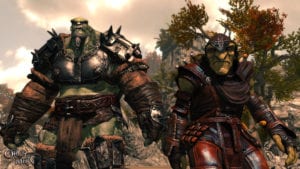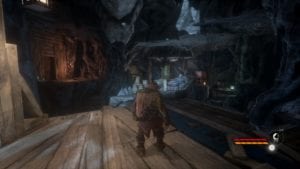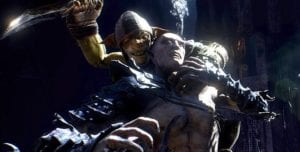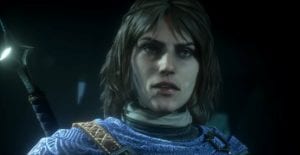The year of 2017 is coming to an end, so nerdy writers like us are inevitably going to talk about things they’ve seen, read and played during it. And I’m no exception – I’d like to tell you all about a game you may not have heard about. It’s Styx: Shards of Darkness.
Now, this game is a third one in the series… in a manner of speaking. So I need to provide a bit of background, first. While I will avoid spoilers for Shards of Darkness (henceforth SoD), I will talk a bit about the other games’ plots.
A Little History
The main character, Styx, first appears in an unusual action-RPG hybrid Of Orcs and Men. Arkail, an orc warrior with a temper problem (if one can call uncontrollable berserker rage that) joins a mission to kill the human emperor. The orcs see it as their last chance to prevent human expansion into their territory and enslavement of their people. Each member of the elite Bloodjaw warband is to cross the great wall and infiltrate human lands with a hired guide. For Arkail, this turns out to be a wise-cracking goblin assassin, Styx.
Arkail is less than convinced… because Styx is the only goblin to ever speak or display more intelligence than a rabid dog. All the other goblins are marauding monsters that had appeared out of nowhere, a hundred years before the game’s start. If Styx knows anything about that, he refuses to tell anything, simply saying that he’s “different” and “a survivor”.
Grumbling aside, the two companions go on with the mission, their dynamic being central to the gameplay. Arkail is a large warrior who has to manage his burning rage, while Styx is a canny assassin who eliminates targets with a pair of daggers and a set of throwing knives.

Eventually, while the unlikely duo is going on a mental journey into a mage’s mind in order to save her, the truth comes out. Styx has to confront a deep part of himself that reveals he used to be an orc mage who experimented with a substance called “Amber” and turned himself into a grotesque version of an orc. Then he spawned the rest of goblinkind. Whether he embraces the truth or keeps repressing it is up to the player, but it doesn’t affect much.
Styx: Master of Shadows is a prequel that goes all the way back to Styx’s origins. Styx is trying to reach the heart of a World-Tree that excretes Amber… the very same thing that turned him into what he is. Although he can create clones now (and use abilities he certainly does not have in Of Orcs and Men), they disappear after a while and there are no goblins yet.
Master of Shadows ends with the World-Tree destroyed and a horde of goblins swarming out of the wreckage. Styx himself has forgotten most of what happened and moves on.
Shards of Darkness picks up some time after that. Styx has established himself as an elusive mercenary, while his sorry progeny has caused major devastation. I’m not sure how a horde of small, runty and dumb green people managed to destroy an entire town, but I’ll take their word for it.
The Essence of the Game
After a routine job, Styx encounters Helledryn, the head of the CARNAGE squad… which hunts goblins. The woman has a job for him, and plenty of Amber (which Styx is addicted to and which is the source of his powers) to give him in exchange. To the surprise of no one, he ends up getting in way over his head, just like he would do again 50 years later or so.

Much like Master of Shadows, Shards of Darkness is a stealth game. The core of the gameplay remains the same. Styx has to sneak through large maps in pursuit of primary and secondary objectives. The levels, much like in the previous game, are as much vertical as they are horizontal. Styx will jump and climb frequently. He’s got some jumping power in those stumpy legs. There’s always more than one path to your objective, and good spatial awareness will benefit you.
Map design remains pretty stellar, although once again, maps are also reused. You return to areas you’ve already explored eventually. Then again, you do so for good in-story reasons, so perhaps it makes more sense than always finding yourself somewhere new.
The Styx franchise is somewhat different from many other stealth games in that directly engaging enemies isn’t much of an option. When an enemy catches up to you, you’ll have to parry their attacks until you can go in for the kill. When two enemies attack you, or someone has a ranged weapon, they’re free to turn you into a goblin shish-kebab.
Thus it’s easy to dispatch a single enemy if things go wrong, but the game still encourages you to sneak around. If they spot you, there’s always the option to run and hide. Particularly as some enemies you can’t fight at all. Heavily-armored enemies such as knights, dark elf elite guards and dwarves will simply kill you. They’re also entirely immune to Styx’s dagger and crossbow bolts (it’s a tiny, wrist-mounted crossbow), so if you want to get rid of them, you’ll have to be clever. Poison their food, drop something heavy on them or use an acid mine. The last part also gets rid of the body, as Styx can’t carry someone so heavy.
Although it’s possible to run and hide from enemies, in both games I gave myself a challenge of never being spotted at all. Which isn’t easy, but possible and rewarding. You get extra experience for it, as well, which you spend on Styx’s skills. You also get it for being quick (something I could never get more than a bronze medal in), finding all small tokens in a given level (I never bothered to do it) or not killing any enemies.
In Master of Shadows, playing mercifully was difficult. You couldn’t kill anyone at all to get that medal for a particular level, and it could be very hard to avoid detection otherwise. So it you wanted to do it, you would have to forgo the medal for non-detection… or at least, I can’t imagine doing both.
On the other hand, in Shards of Darkness, I found it much easier to go through levels without killing. Perhaps it’s by design, or perhaps I was better at the game? It wouldn’t surprise me if it was a design decision to make such a playstyle a more attainable challenge. In addition, all medals are gradual. Killing no one gets you gold, but killing five or less gets you silver.
One Crafty Goblin
Shards of Darkness also introduces crafting. This is normally something that fills me with dread, but it wasn’t as bad as I’d thought. In the original game, you pick up potions, throwing knives and other items and you have a limit of how many you can carry. The second one adds an extra decision point – you find raw materials and you must decide what to make from them. Will you use the iron ore on crossbow bolts, lockpicks or acid mines?
Of course, because crafting will always be crafting, some materials are scarce and some you’ll carry around in abundance. This depends on what items you learn to craft, but still. You’ll always be short on iron ore and raw Amber, because you use them to craft items you use all the time. Others only go into more situational and later-game items… for which you’ll also need iron or Amber, in many cases.
Although the games play the same, I couldn’t help but feel like the second one is… easier? Perhaps it was the increased ease of a non-violent approach. And the game did grow more challenging later, particularly as we encounter dwarves. Who are entirely typical fantasy dwarves… except for their keen noses. They can pick up a greenskin’s smell easily, which means Styx can’t rely on the shadows to hide him.
They’re easily the most difficult enemy to get past, and the real purpose of acid mines. Those are normally impractical, as by the time you maneuver an enemy into it, you can just bypass or kill them. But they’re a way to kill a dwarf without being spotted.
In other ways, Shards of Darkness expands on the first game’s options. There are more skills and Styx can actually change his equipment. Each dagger or outfit comes with benefits and drawbacks… although a dagger that muffles any kill but makes parrying impossible is a straight-up benefit for a no-detection run. A dagger that instantly dissolves a killed enemy but can’t make quiet kills (which take longer but make less sound) is tricky… unless you take skills that let you muffle the sounds of assassination. An outfit you can unlock through skills lets you craft anywhere, but makes running and jumping noisier. And so on.
All of it doesn’t kick in until later, when you get all sorts of gear and skills to combine into clever strategies. I was able to, for instance, attack an enemy from several meters, then kill them quickly, noiselessly and almost invisibly. And with the dagger I mentioned above, I left no body behind. This tempts me to play the game on NG+, something I’m normally not fond of doing.

Going Too Far
Where I did notice a problem with the game was the writing. Specifically, the main protagonist. Styx captured the hearts of the audience by packing enough snark, experience and swearwords to equip a biker gang into a four-feet-tall body. He retains that personality in the other games… but by Shards of Darkness, it feels like it goes too far.
It’s not an uncommon thing, I think. Many characters find their traits exaggerated over time. And I think that’s what happened with Styx. The writers had a protagonist who was notably snarky, cynical, disrespectful and had a dark sense of humor. So Shards of Darkness has him constantly joke, swear, insult people… it grates sometimes. It’s hard to empathize with a protagonist who never seems to take anything seriously, until he gets angry.
The absolute worst case is Styx insulting the player through the fourth wall when he dies. I really don’t know who thought it was a good idea and I turned it off more or less immediately. This is a good example of that, I think. “Hey, Styx is a rude jackass, why don’t we have him be one to the player?” He also breaks, or just leans on, the fourth wall in other places. It’s not as direct, but does sound forced. Which is generally how it goes; sometimes it feels like the writers try too hard to make sure we know he’s a crude, irreverent and selfish little guy.
This is particularly uncomfortable when it comes to Helledryn, whom I mentioned early on. She’s a goblin-hunter who works with Styx out of necessity. She’s a large woman… though, frankly, not nearly as much as you’d think when hearing people mention it. Styx, who isn’t happy about working with her, never passes up an opportunity to rib her about it. He delights in calling her a “cow”, particularly. Again, he’s a bastard who insults everyone. But when the most frequent and consistent target is a woman, and most of it concerns her size… it’s not a very good impression.

The rest of the writing is serviceable. The world-building is very clearly ad hoc, the writers making it up as they go. The world and story already don’t mesh well with Of Orcs and Men, particularly as Styx has no powers in that game. The game ends with a clear sequel hook, though, so I expect Styx to lose them and his Amber addiction. It’s not really a bad thing – the world, threadbare as it is, is still more appealing than the generic setting in Of Orcs and Men.
Worth Recommending
Despite my misgivings about a protagonist I had initially loved (I very much like goblins in fantasy), Styx: Shards of Darkness is a refinement of the first game’s already solid formula, that delivers the same experience with extra features. Of Orcs and Men is an entirely different game, and very rough around the edges. But it’s still worth investigating if you want something you may not have otherwise seen. And both Styx games are ideal if you want tough, channeling stealth games where you have to think on your feet and consider every angle.

